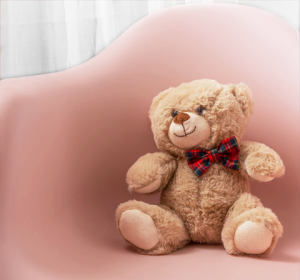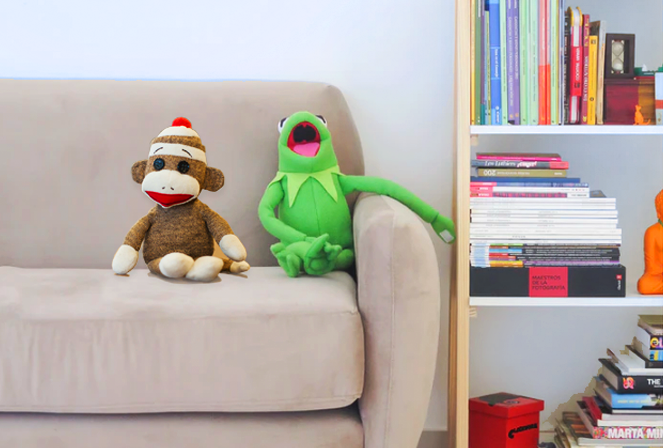With many of us staying at home a lot of the time, it’s more important than ever to create a fun and safe space for your kids to play and learn.
For a room with the purpose of playing and having a good time, you want the playroom colors and designs to match up with that whimsical and fun feeling.
Here are a few tips to get you inspired.
Let the Toys Take Center Stage
It’s easy to get caught up in what the best playroom colors are for the walls, carpets, decor, etc.
However, I would suggest letting the toys take center stage. The entire purpose of the room is for playing, and most children aren’t going to be examining what types of colors the walls are!
I suggest downplaying the decorative colors in the room so that the toys are the most important visuals in their playspace.
Many toy designers are aware of what colors are best for learning and development, which means there’s less work for you in choosing colors of toys for children.
Check out this awesome resource from Kaplan Learning about some color ideas for childhood learning and development to find some great information.
Combine Decoration and Practicality
Keeping the playroom organized and clean is going to be a battle you likely fight every day. Playrooms are meant to get messy and crazy — that means your kids are having fun, exploring and learning through play.
That doesn’t mean that you can’t implement some practical organization tools that can also stimulate the mind. For example, brightly colored storage bins are a great choice to get some more color into the room and provide a place to store toys, blocks, arts & crafts and more.
You can even make a game out of it: have the kids put toy cars in red bins, stuffed animals in blue bins, art supplies in yellow bins, etc. This helps them learn their colors, learn about organizing and makes it a game that they can enjoy.
Other ideas include tables with storage for art supplies, colored bookshelves that kids can reach, whiteboard/chalkboard walls (a great DIY paint project!) and more.
Avoid Overstimulation & Overdecoration
I understand that the instinct with rooms for children is to load it with bright colors, designs, shapes and more. However, this can backfire as it can lead to overstimulation.
Too many bright colors, or even too many colors in general, are overwhelming for kids and adults alike! I suggest choosing a few key colors that you can feature throughout the room and keep the rest neutral.
Let’s say you use a navy blue accent in the playroom. Choose furniture in softer grays and use a navy blue rug and perhaps a few pillows. I suggest using your accent color sparingly for the best result.
Want more specific tips on kids’ room colors?
Check out my blog post on kids’ room design and examples of my work here.
Overdecoration can also lead to overstimulation and it’s usually unnecessary! Kids are there to play, not to admire the post-modernist contemporary style that you want to achieve, for example.
Not only that, but overdecoration leads to the space feeling cluttered and messy. Toys everywhere are just kids’ being creative while they actively play with what seems like every toy they own!
Keeping things simple decoration-wise will also make it easier to adjust and change the room as the children grow, their interests change and as they develop with age. Instead of having to switch out full designs and decor, you’ll simply change up the toys and activities.
Colors I Suggest
The colors I recommend for a room full of activity and colorful toys are delicate and understated.

Pale blues or teals, soft grays or even soft pinks are colors that will not compete with the energy in the room. Any of these colors can be used with both boys and girls.
The softer the color palette, the less it will conflict with the exciting activities going on in the same space!
Lighting
Alongside playroom colors, make sure you make strong lighting choices for your playroom.
Great lighting, especially natural lighting, helps keep kids focused and makes it easier for kids to read, write, play, create and learn. It can also reduce eye strain and let them focus on the adventure they are on with their characters and toys.
Make It a Place for Adults, Too!
You and other adults are going to be spending a lot of time in this playroom, too!
Make sure there’s a place for mom, dad, babysitter or any other caregiver where they can chaperone, relax and enjoy time with the kids.
This means an adult-sized chair (no squeezing onto those tiny plastic ones!), some activities for you (a reading nook, your own projects, etc) and anything else that will make your experience in the playroom comfortable and fun as well.
Give yourself a space to be creative in the family playroom. I love the idea of sharing what the adults accomplished while the kids were playing. It might even be something they are proud to share with their friends, how cool is that!
Playroom Colors & Designs: Keep It Simple and Comfortable!
We all know the feeling of getting a child an amazing or fancy new toy and have them enjoy playing with the box as much as they’ve enjoyed playing with the toy!
My suggestion is to add a variety of toys and activities into the room. Maybe there will be a section with games, another section with art supplies, and a third section for reading or doing puzzles.
The more variety there is in a space, the more they will enjoy the room. I have personally found that playrooms are successful when there is a lot to do in there and the child enters with a sense of adventure not knowing where to start!
Remember it’s about what there is to do in the space, not what the space will do for you!
Stay focused on what there is to do, that’s what it’s all about.
The same idea translates to choosing playroom colors and designs: keep the room simple. It’s all about what there is to do in the room, that’s the bottom line!
How have you decorated your playrooms? I’d love to hear your ideas and feedback in the comments below!
If you need some more support or advice, don’t hesitate to contact me for color expert approved tips!


Good morning, Amy! With so many people participating in the #oneroomchallenge right now, I bet they would find your post very interesting, if you shared it on the tag. You have hit on something that a lot of people don’t think through well, I think: how the toys will impact the color energy of a child’s playroom, and the overall decorating scheme.
Thanks for some good food for thought!
This is such great advice to keep the colors calming and allow the toys to be the stimulating colors. I think too many parents think kids need bright wild colors to make them happy. Excellent post Amy!
Thanks Linda, I think you’re absolutely right. More color doesn’t add more fun, adding the right colors is the way to go!
Hello Amy! I love your tips! Great inspiration to redo my little girls space soon!
Thanks Lauren, I’m so glad you found this post inspiring!
Great advice, Amy, to keep it simple – there’s already a LOT going on in a playroom! I love the suggestion to create adult space in the playroom too – no more squeezing onto tiny plastic chairs indeed!
I’m so glad you enjoyed my advice Janet, the room has to work for the grown-ups too!
Such good tips for a play room! I think you are very insightful in your approach to design
Thank you so much Lisa, I’m always thinking of what makes a space work both visually and practically!
I know someone whose young daughter wanted a black and fuchsia room. I suggested, maybe let’s use a much softer hue than fuchsia. Now I can point them here! Great post.
Thanks Rebecca. Yes, I would definitely suggest using a color that is easier on the eyes, it can make a world of difference!
Having owned and operated a children’s daycare center long ago, I can say you are spot on! White makes a great background for all the toys. It’s easy to keep free of marks on the walls and baseboards with a magic eraser.
I am so happy to see your comment Christina, thanks so much! I know with kids of my own the softer approach was definitely the way to go!
What great advice – love the idea about including a place for adults
Thanks Anne-Marie, it’s so important to design the space for everyone to hang out in! Glad you enjoyed this post.
Great advice on how to use color to make the play room work for both kids and adults and be both fun and cheerful but not over-stimulating. Color is amazing in how it can meet so many needs at one time if done right!!
Yes you are so right Mary Ann, and I know you appreciate what we can accomplish with the right colors!
I loved the thought that you need to make the space comfortable for adults also! In choosing colors, yes I have been in rooms that made ME crazy with overstimulation I can’t imagine how it worked for the kids!
I love your comment Suzi, overstimulation is a real issue and I am so glad you are sensitive to it as well!
This is great advice, Amy. I loved how you talked about not make the space over-stimulating.
Thanks Sheri, it is a situation I come across often with homeowners designing spaces for their children, so much so that it inspired this blog post! I’m so glad you enjoyed my advice!
Lots of great insight here. When I had my son, I got really into Montessori principles for designing his space and selecting his toys (as much as possible). It’s much softer, organic, and calming because of the wood and natural textures yet it’s still stimulating.
I love your comment Jillian, it sounds like our design aesthetics overlap. I hope you were happy with the results of all of your efforts!